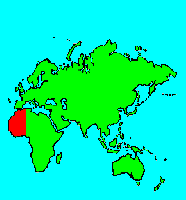SPECIES INFO
The green turaco (Tauraco persa) is found from Senegal south to northern Angola. This 17 inch turaco has a green crest, neck, and breast. The dorsal wings and tail are dark reddish brown in the west African forms, but the southern African forms show green dorsal wings when perched but lots of red dorsally on the wings in flight.
There are three subspecies. The subspecies buffoni is found in Senegal, Liberia, and Gambia. The subspecies persa is found from Ivory Coast through Nigeria to Cameroon. The subspecies zenheri is found from southern Cameroon to northern Zaire and south to northern Angola.The Turaco (Tauraco) genus contains about 14 species of large colorful birds that are found only in Africa. They are found in woodlands. They nest high in forest trees. These are generally very colorful birds. The crest is usually green or white. The young hatch and leave the nest within 10-12 days, and stand on branches waiting to be fed.
The genus named was spelled Turacus abouty 50 years ago.
Touraco or turaco (Family Musophagidae) are a family of 23 species of soft-feathered birds that are found only in Africa. These are fairly large birds normally between 15 and 25 inches in length. Many species are very colorful. The bodies can be green or blue with red markings on the wings. These birds feed primarily on fruits. Some taxonomists place this family near the owls. Some modern taxonomists place this family near the cuckoos.
We have divided the family in three sections following the lead in Howard and Moore. This division permits groupings that will facilitate study of the family.
Touraco or turaco and Go-Away Birds (Order Musophagiformes) are a collection of 23 species of soft-feathered birds that are found only in Africa. These are fairly large birds normally between 15 and 25 inches in length. Many species are very colorful. The bodies can be green or blue with red markings on the wings. These birds feed primarily on fruits. Some taxonomists place this family near the owls. Some modern taxonomists place this order as a family near the cuckoos.
Aves contains about 8,650 different species of living birds known to science. Each year about one new species is discovered in some remote rain forest or remote island. In addition, scientists have been raising many subspecies to full species status which may raise the species count to 10,000. Birdlife recognizes 10,027 species as of 2011.
However, each year about one species goes extinct. The rate of extinction is increasing, and the rate of new discovery is decreasing, so that the number of bird species will soon begin to decline rapidly. Although different taxonomists would organize the birds differently, there are approximately twenty-seven orders of birds. These orders are broken down into about one hundred and fifty-five different families.
Recent research of the genetic structure of some of the shore birds and owls would indicate that the present organization of orders and families should have some modification.
The birds are a worldwide group of animals that are characterized by having the front limbs modified into wings that are used for flying. Perhaps the most unique feature of the birds is the feathers. These feathers are made up of a central support called a quill and a series of small filaments that are hooked together as barbs.
For many years it was believed that Archaeopteryx discovered in Bavaria was the oldest bird from about 150 million years ago. However, in l986, Sankar Chattterjee, a Texas paleontologist, reportedly discovered a bird in the genus Protoavis that lived about 225 million years ago.
When this project was begun in 1978, we used Austin & Singer for bird taxonomy. Since then, we have adopted many changes, but have kept some older concepts that are still found widely in the literature. Recently, we have used Clements and Howard & Moore. Very recently, we have used Monroe and Sibley for the higher taxonomy of the perching birds.
Backboned Animals (Phylum Chordata) are the most advanced group of animals on earth. These animals are characterized by having a spinal cord or backbone. Most members have a clearly defined brain that controls the organism through a spinal cord. Fish, amphibians, reptiles, birds, and mammals are in this phylum.
Currently, some taxonomists believe that the fish should be divided into two groups (sharks and regular fishes) and that there are some other primitive groups in the phylum such as hagfish or lampreys.
Animal Kingdom contains numerous organisms that feed on other animals or plants. Included in the animal kingdom are the lower marine invertebrates such as sponges and corals, the jointed legged animals such as insects and spiders, and the backboned animals such as fish, amphibians, reptiles, birds, and mammals.


